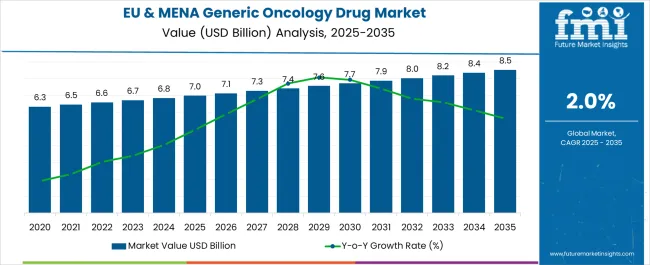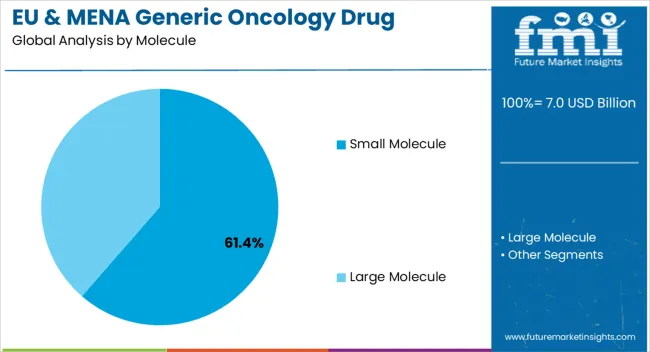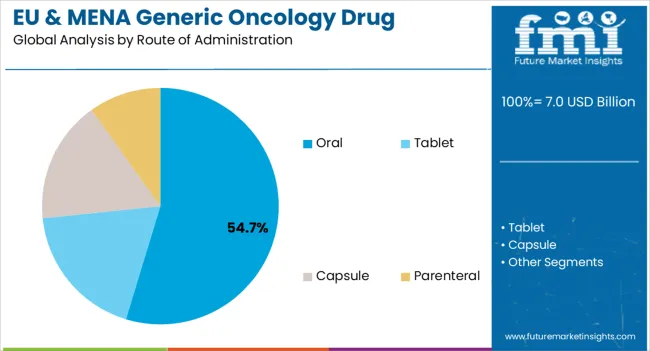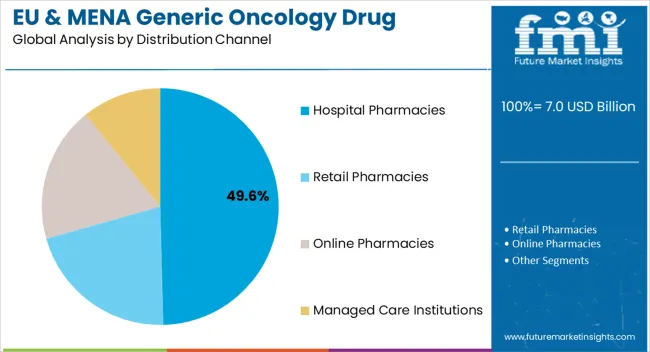The Europe and MENA Generic Oncology Drug Market is estimated to be valued at USD 7.0 billion in 2025 and is projected to reach USD 8.5 billion by 2035, registering a compound annual growth rate (CAGR) of 2.0% over the forecast period.

| Metric | Value |
|---|---|
| Europe and MENA Generic Oncology Drug Market Estimated Value in (2025 E) | USD 7.0 billion |
| Europe and MENA Generic Oncology Drug Market Forecast Value in (2035 F) | USD 8.5 billion |
| Forecast CAGR (2025 to 2035) | 2.0% |
The Europe and MENA generic oncology drug market is advancing steadily as demand for cost-effective cancer therapies continues to grow. Increasing cancer prevalence, strong emphasis on affordable treatment access, and expanding generic drug approvals are supporting market expansion. Current dynamics reflect pressure on healthcare systems to balance quality outcomes with economic efficiency, leading to rising adoption of generics across oncology treatment pathways.
Regulatory frameworks in both Europe and MENA are fostering generic penetration by streamlining approval processes and encouraging competition. Future growth is expected to be driven by patent expiries of blockbuster drugs, enhanced manufacturing capabilities, and broader distribution networks across emerging economies.
Affordability, availability, and therapeutic equivalence are strengthening confidence among healthcare professionals and patients, while the shift toward oral and targeted therapies is reshaping treatment models The rationale for growth rests on accessibility improvements, healthcare policy alignment, and strategic investment by manufacturers to ensure consistent supply and compliance, all of which are positioning the market for sustained long-term expansion.

The small molecule category, holding 61.40% of the molecule segment, has remained the dominant contributor to the market. Its leadership is attributed to wide therapeutic applicability, well-established manufacturing processes, and consistent demand from oncology care providers.
Small molecules offer scalability and cost efficiency in production, which aligns with healthcare priorities for affordable treatment solutions. Regulatory confidence in therapeutic equivalence has further reinforced adoption across Europe and MENA.
Continued availability of generics following patent expiries has strengthened market penetration, while enhanced quality control and distribution reliability have ensured steady supply The segment’s dominance is expected to be maintained as patient populations expand and treatment protocols continue to integrate generics as first-line options in cancer care.

The oral route, representing 54.70% of the administration category, has been leading due to patient convenience, reduced hospitalization requirements, and compatibility with outpatient treatment models. Growth has been supported by the increasing number of oral oncology drugs transitioning into generic versions, allowing wider accessibility.
The oral format improves adherence and quality of life for patients, making it a preferred option among prescribers. Regulatory frameworks and clinical guidelines have encouraged integration of oral generics into treatment regimens.
Supply chain efficiencies and expanded retail and hospital pharmacy distribution have reinforced availability The segment is expected to retain its leadership as innovation in oral formulations continues and healthcare providers favor patient-centered, cost-effective delivery models.

The hospital pharmacies segment, accounting for 49.60% of the distribution channel category, has emerged as the primary point of access for generic oncology drugs. Its dominance is driven by established procurement systems, institutional trust, and the ability to ensure regulated handling of oncology medicines.
Hospital pharmacies provide centralized dispensing for both inpatient and outpatient care, ensuring timely and safe access. Partnerships between hospitals and generic drug manufacturers have supported bulk purchasing and consistent supply.
Clinical oversight and integration into hospital treatment protocols have further reinforced preference for this channel With continued investment in hospital infrastructure and the expansion of oncology care centers across Europe and MENA, hospital pharmacies are expected to sustain their market leadership and remain a critical distribution hub for generic oncology drugs.
Generic drugs in oncology are providing a new ray of hope to millions of patients suffering from cancer across Europe and MENA. They have become cost-effective alternatives to branded medicines.
Generic oncology drugs are gaining immense popularity across regions such as Europe and MENA. This is due to their several benefits, including cost-effectiveness and high efficiency. The growing adoption of these generic cancer drugs is expected to boost the target business.
Oncology drugs are typically characterized by high costs and limited accessibility for the general public. Cancer treatments can be particularly challenging due to the exorbitant prices of these drugs. However, generic cancer medications provide a crucial solution, offering comparable therapeutic effectiveness at around 80% less than their branded counterparts.
Utilizing generic oncology drugs significantly reduces the financial burden of cancer treatment, ultimately enhancing the prospects of patients receiving more comprehensive care. Sales of generic injectable drugs and off-label medications have played a pivotal role in driving down the overall cost of cancer treatment, making it more manageable for a broader patient population.
The Europe and MENA generic oncology drug business accounted for around 2.0% of the overall global generic oncology drug space in 2025. The latter was valued at USD 333.5 billion. Over the assessment period, generic oncology drug sales in Europe and MENA are projected to soar at a 2.1% CAGR.
The Europe and MENA regions have experienced significant transformations in the field of generic oncology drugs in recent years. This has opened new growth prospects for generic oncology drug companies, and the trend is expected to continue through 2035.
The MENA region is observing a notable increase in cancer incidence, primarily attributed to factors such as an aging population, lifestyle changes, and improved cancer diagnosis and reporting. This is expected to drive demand for generic drugs in Europe and MENA.
Regulatory authorities in MENA countries are increasingly recognizing the significance of regulating generic oncology drugs to ensure their safety and efficacy. This will likely boost the target business during the forecast period.
Europe’s generic oncology drug landscape, while relatively mature compared to emerging businesses, continues to evolve due to multiple factors. These include patent expirations of branded oncology drugs, healthcare systems' cost containment efforts, and the growing demand for more affordable cancer treatments.
Increasing investments in oncology drug manufacturing and the rise of the biosimilar cancer drug business are expected to create growth prospects for generic oncology drug companies. Similarly, the flourishing anti-cancer generics sector will boost revenue through 2035.
The availability of cancer drugs has been a persistent concern among patients, often compounded by their high costs. The introduction of generic versions of certain medications faced initial hurdles, with a handful of general practitioners in specific countries encountering legal threats for prescribing generic alternatives still under patent protection.
The landscape, however, has changed significantly with the widespread availability of oral generic oncology drugs, resulting in substantial price reductions of up to 98.8% across Europe. Target prices for several generic oncology drugs were considerably lower than their branded counterparts, with substantial reductions.
For example, the targeted cost for bortezomib was set at USD 499.34 per treatment cycle, dasatinib at USD 10.93 per month, everolimus at USD 1,035 per month, and gefitinib at USD 12.15 per month. In comparison to the prevailing list prices in England, these target prices represented a remarkable reduction of 74% to 99.6%.
The adoption of generic oncology drugs has significantly improved the affordability of cancer treatment. This has led to an enhanced likelihood of patients receiving comprehensive and effective care, addressing both the concerns of drug availability and cost.
The impact of pay-for-delay or reverse payment settlements on consumer costs and healthcare accessibility in the pharmaceutical sector has sparked concerns. Under these agreements, manufacturers of brand-name drugs agree not to introduce their approved generics during the exclusivity period in exchange for generic drug makers delaying the release of their less expensive equivalents of the brand-name products. Although the firms involved can perceive this as a good bargain, consumers and the healthcare system will suffer as a result.
The financial strain on consumers is one important outcome. Pay-for-delay contracts essentially prolong the monopoly period of name-brand prescriptions, compelling patients to purchase pricey prescription drugs. These agreements also postpone the release of generic cancer alternatives that are more reasonably priced.
Patients are consequently unable to transfer to equivalently effective but less expensive drugs. Hence, pay-for-delay settlements hurt patients and the healthcare system even though the pharmaceutical corporations implicated can profit from them.
The below table shows the estimated growth rates of the top countries in Europe and MENA. Among these, Libya, Israel, and Sudan are set to exhibit lucrative CAGRs of 9.3%, 8.3%, and 8.8%, respectively, through 2035
Growth Outlook by Key Countries
| Countries | Value CAGR |
|---|---|
| United Kingdom | 1.5% |
| Germany | 1.9% |
| France | 2.0% |
| Italy | 1.3% |
| Spain | 2.9% |
| BENELUX | 2.7% |
| Nordics | 1.1% |
| Poland | 2.0% |
| Hungary | 2.4% |
| Romania | 2.8% |
| Czech Republic | 2.2% |
| Rest of Europe | 1.3% |
| Saudi Arabia | 2.2% |
| Egypt | 2.7% |
| Algeria | 3.2% |
| United Arab Emirates | 3.7% |
| Kuwait | 4.2% |
| Jordan | 4.7% |
| Türkiye | 5.2% |
| Iran | 5.7% |
| Morocco | 6.3% |
| Qatar | 6.8% |
| Oman | 7.3% |
| Bahrain | 7.8% |
| Israel | 8.3% |
| Sudan | 8.8% |
| Libya | 9.3% |
| Rest of MENA | 9.7% |
Poland occupied 12.2% of the Europe and MENA generic oncology drug business share in 2025. Over the assessment period, Poland’s generic oncology drug business is set to thrive at a 2.0% CAGR, totaling USD 8.5 million by 2035.
Several factors are expected to boost growth in Poland during the forecast period. These include rising awareness of the benefits of generic oncology drugs, the establishment of new pharmaceutical companies, the growing popularity of targeted therapies, and advancements in the cancer treatment drug sector.
The strategic geographical location of Poland in Europe further enhances its attractiveness as a base for pharmaceutical companies seeking access to both Eastern and Western regions. This will positively impact the overall growth of the target business in Poland.
Pharmaceutical companies find Poland attractive because of its commitment to improving its business and research climate. This is demonstrated by its proposed measures, especially in the field of generic oncology medications.
The country is launching new programs and initiatives to improve its business and research climate. These involve creating clusters of high-tech businesses, encouraging commercial and academic collaboration, and providing funding for research & development and public procurement to encourage research.
Poland is projected to become an even more attractive location for pharmaceutical businesses that specialize in generic oncology drugs as long as it keeps investing in innovation and technology. This presents significant prospects for business growth, which will eventually help patients by expanding access to high-quality, reasonably priced oncology treatments.
The United Kingdom’s generic oncology drug business size is predicted to reach USD 906.54 million by 2035. Over the forecast period, demand for generic oncology drugs in the United Kingdom is expected to rise at a 1.5% CAGR.
Increasing cancer incidence is a primary factor expected to fuel sales of generic oncology drugs in the United Kingdom. Similarly, the growing popularity of biosimilars, favorable government, and rising awareness about the benefits of generic oncology medicines support will likely boost the target business.
In recent years, there has been a spike in cancer across the United Kingdom. For instance, as per the World Cancer Research Fund, around 387,820 cases of cancer were diagnosed in the United Kingdom in 2020. This rise in cancer cases is expected to drive demand for generic oncology drugs.
In the United Kingdom, generic producers are aggressively pursuing opportunities in this evolving landscape. They aim to capture a significant share by offering affordable alternatives to these soon-to-be off-patent drugs, including generic oncology medications.
In 2025, Germany held a significant share of the Europe and MENA generic oncology drug business, with a valuation of USD 617.0 million. For the projection period, a CAGR of 1.9% has been predicted for Germany. By 2035, total generic oncology drug revenue in Germany is set to reach USD 762.27 million.
Multiple factors are expected to drive growth in Germany through 2035. These include rising demand for generic cancer drugs due to their affordability and safety, surging popularity of super generics, and increasing cases of cancer.
Germany, an established country for generic oncology drugs, combines cutting-edge innovation, a rich tradition as the ‘world's pharmacy,’ and a consistently growing demand for healthcare products. With a strong emphasis on pharmaceutical research and development, production, and sales of medicines, the country is set to observe steady growth.
Germany is striving to advance in cancer diagnostics and treatment. For instance, declaring the upcoming ten years to be the ‘National Decade against Cancer,’ the Federal Ministry for Education and Research started implementing plans to give oncology research top priority. This will bode well for the target business.
The below section shows the small molecule segment dominating, based on the molecule. It is forecast to thrive at 1.9% CAGR between 2025 and 2035. By route of administration, the oral segment is expected to generate significant revenue in Europe and MENA. It will likely exhibit a CAGR of 1.5% through 2035. Based on the distribution channel, the retail pharmacies segment is set to lead the target business, thriving at a 1.6% CAGR.
Growth Outlook by Key Molecule
| Molecule | Value CAGR |
|---|---|
| Large Molecule | 2.6% |
| Small Molecule | 1.9% |
Based on the molecule, the small molecule segment held a 73.1% value share in Europe and MENA in 2025, and it will likely retain its dominance through 2035. Demand for small-molecule cancer drugs is predicted to rise at a CAGR of around 1.9% during the assessment period.
Small molecule generic oncology drugs are gaining attention and hold an impressive share due to their cost-effectiveness in manufacturing than biologics. This can help reduce the overall cost of cancer treatment.
Small molecule drugs are easy to manufacture and can be administered orally. This is further making them popular and fueling their demand across regions such as Europe and MENA. Also, their molecular size and complexity enable them to reach target sites easily, resulting in high drug efficacy.
To meet this demand and boost their revenue, key generic oncology drug manufacturers are expected to introduce new small molecule generic cancer drugs through 2035. They will also benefit from the expanding small-molecule injectable business.
Growth Outlook by Key Route of Administration
| Route of Administration | Value CAGR |
|---|---|
| Oral | 1.5% |
| Tablet | 1.3% |
| Capsule | 1.9% |
| Parenteral | 2.7% |
By route of administration, the oral segment held a 54.3% value share in Europe and MENA business at the end of 2025. In the assessment period, the target segment is anticipated to progress at a CAGR of 1.5%.
Oral medication remains the preferable route of drug administration across Europe and MENA. This is because of its advantages, such as better convenience and inexpensive nature.
Oral medications tend to be more readily accepted by patients, which promotes greater adherence to prescribed treatment regimens, ultimately leading to improved health outcomes. As a result, they are in greater demand across regions such as Europe and MENA.
Oral anti-cancer drugs are generally less invasive and cost-effective than parenteral cancer drugs. These advantages are expected to encourage the adoption of oral generic oncology drugs during the forecast period, thereby boosting the target segment.
Growth Outlook by Key Distribution Channel
| Distribution Channel | Value CAGR |
|---|---|
| Hospitals Pharmacies | 2.2% |
| Retail Pharmacies | 1.6% |
| Online Pharmacies | 3.4% |
| Managed Care Institutions | 4.2% |
As per the latest generic oncology drug industry analysis, retail pharmacies remain the most preferred distribution channel for generic oncology drugs across Europe and MENA. The target segment accounted for a revenue share of 60.1% of the total value in 2025.
Over the forecast period, the retail pharmacies segment is expected to demonstrate steady growth with a CAGR of 1.6%. This can be attributed to the rising inclination of cancer patients toward purchasing generic oncology drugs from retail stores.
Retail pharmacies provide a diverse selection of generic alternatives, empowering consumers to reduce their healthcare costs. Moreover, across several nations in Europe, pharmacists are granted the authority to replace brand-name prescriptions with generic counterparts when they are accessible unless a healthcare provider specifies otherwise.
The Europe and MENA generic oncology drug business landscape has evolved into a fiercely competitive arena, with several manufacturers of generic oncology drugs competing for dominance. In their quest for a competitive edge, these stakeholders are actively involved in strategic endeavors. These initiatives encompass new product launches, regulatory approvals, collaborations with healthcare institutions, and the development of combination therapy approaches.
Recent Developments in the Europe and MENA Generic Oncology Drug Business-
| Attribute | Details |
|---|---|
| Estimated Value (2025) | USD 7.0 billion |
| Projected Value (2035) | USD 8.5 billion |
| Anticipated Growth Rate (2025 to 2035) | 2.0% CAGR |
| Forecast Period | 2025 to 2035 |
| Historical Data Available for | 2020 to 2025 |
| Industry Analysis | USD billion for Value |
| Key Regions Covered | Europe; and Middle East; and North Africa |
| Key Countries Covered | United Kingdom, Germany, France, Italy, Spain, BENELUX, Nordics, Poland, Hungary, Romania, Czech Republic, Rest of Europe, Saudi Arabia, Egypt, Algeria, United Arab Emirates, Kuwait, Jordan, Türkiye, Iran, Morocco, Qatar, Oman, Bahrain, Israel, Sudan, Libya, rest of Middle East and Africa |
| Key Segments Covered | Molecule, Route of Administration, Distribution Channel, and Region |
| Key Companies Profiled | Cipla; Eli Lilly & Co.; GlaxoSmithKline Plc.; Sanofi S.A.; Teva Pharmaceutical Industries Ltd.; Sun Pharmaceutical Industries Ltd.; Lupin Ltd.; Hikma Pharmaceuticals PLC; Viatris Inc. (Mylan N.V); Johnson & Johnson; Takeda Pharmaceutical Company Limited; AstraZeneca; Bristol Myers Squibb Co.; F.Hoffmann-La Roche Ltd.; Bayer AG; Astellas Pharma; Accord Healthcare; Actero Pharma; HEC Pharm; Aqvida GmbH; MEDICHEM S.A.; Pharco Corporation; Krka; Gedeon Richte |
| Report Coverage | Business Forecast, Competition Intelligence, Key Dynamics and Challenges, Strategic Growth Initiatives |
The global Europe and MENA generic oncology drug market is estimated to be valued at USD 7.0 billion in 2025.
The market size for the Europe and MENA generic oncology drug market is projected to reach USD 8.5 billion by 2035.
The Europe and MENA generic oncology drug market is expected to grow at a 2.0% CAGR between 2025 and 2035.
The key product types in Europe and MENA generic oncology drug market are small molecule and large molecule.
In terms of route of administration, oral segment to command 54.7% share in the Europe and MENA generic oncology drug market in 2025.






Our Research Products

The "Full Research Suite" delivers actionable market intel, deep dives on markets or technologies, so clients act faster, cut risk, and unlock growth.

The Leaderboard benchmarks and ranks top vendors, classifying them as Established Leaders, Leading Challengers, or Disruptors & Challengers.

Locates where complements amplify value and substitutes erode it, forecasting net impact by horizon

We deliver granular, decision-grade intel: market sizing, 5-year forecasts, pricing, adoption, usage, revenue, and operational KPIs—plus competitor tracking, regulation, and value chains—across 60 countries broadly.

Spot the shifts before they hit your P&L. We track inflection points, adoption curves, pricing moves, and ecosystem plays to show where demand is heading, why it is changing, and what to do next across high-growth markets and disruptive tech

Real-time reads of user behavior. We track shifting priorities, perceptions of today’s and next-gen services, and provider experience, then pace how fast tech moves from trial to adoption, blending buyer, consumer, and channel inputs with social signals (#WhySwitch, #UX).

Partner with our analyst team to build a custom report designed around your business priorities. From analysing market trends to assessing competitors or crafting bespoke datasets, we tailor insights to your needs.
Supplier Intelligence
Discovery & Profiling
Capacity & Footprint
Performance & Risk
Compliance & Governance
Commercial Readiness
Who Supplies Whom
Scorecards & Shortlists
Playbooks & Docs
Category Intelligence
Definition & Scope
Demand & Use Cases
Cost Drivers
Market Structure
Supply Chain Map
Trade & Policy
Operating Norms
Deliverables
Buyer Intelligence
Account Basics
Spend & Scope
Procurement Model
Vendor Requirements
Terms & Policies
Entry Strategy
Pain Points & Triggers
Outputs
Pricing Analysis
Benchmarks
Trends
Should-Cost
Indexation
Landed Cost
Commercial Terms
Deliverables
Brand Analysis
Positioning & Value Prop
Share & Presence
Customer Evidence
Go-to-Market
Digital & Reputation
Compliance & Trust
KPIs & Gaps
Outputs
Full Research Suite comprises of:
Market outlook & trends analysis
Interviews & case studies
Strategic recommendations
Vendor profiles & capabilities analysis
5-year forecasts
8 regions and 60+ country-level data splits
Market segment data splits
12 months of continuous data updates
DELIVERED AS:
PDF EXCEL ONLINE
Generic Oncology Drugs Market Growth – Industry Forecast 2025 to 2035
Super Generics Industry Analysis in Europe Report - Trends & Innovations 2025 to 2035
Inhalation And Nasal Spray Generic Drugs Market Size and Share Forecast Outlook 2025 to 2035
Europe Radiotherapy Patient Positioning Market Size and Share Forecast Outlook 2025 to 2035
Drug Taste Masking Technologies Market Forecast and Outlook 2025 to 2035
Europe Polyvinyl Alcohol Industry Analysis Size and Share Forecast Outlook 2025 to 2035
MENA Syringes & Cannula Market Size and Share Forecast Outlook 2025 to 2035
Europe Cruise Market Forecast and Outlook 2025 to 2035
Drug-Gene Interaction Panels Market Size and Share Forecast Outlook 2025 to 2035
Drug Testing Systems Market Size and Share Forecast Outlook 2025 to 2035
Drug Tester Market Size and Share Forecast Outlook 2025 to 2035
Europe Massage Therapy Service Market Size and Share Forecast Outlook 2025 to 2035
Europe Cement Market Analysis Size and Share Forecast Outlook 2025 to 2035
European Union Tourism Industry Size and Share Forecast Outlook 2025 to 2035
Europe Injection Molding Machines Market Size and Share Forecast Outlook 2025 to 2035
Europe Injection Moulders Market Size and Share Forecast Outlook 2025 to 2035
Drug Device Combination Products Market Size and Share Forecast Outlook 2025 to 2035
MENASA Commercial Vehicle Market Size and Share Forecast Outlook 2025 to 2035
Europe Masking Tapes Market Size and Share Forecast Outlook 2025 to 2035
Europe Liners Market Size and Share Forecast Outlook 2025 to 2035

Thank you!
You will receive an email from our Business Development Manager. Please be sure to check your SPAM/JUNK folder too.
Chat With
MaRIA